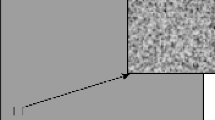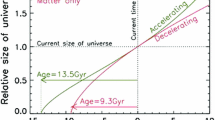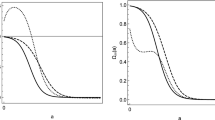Abstract
Quantum fluctuations of a real massless scalar field are studied in the context of the generalized uncertainty principle (GUP). The dynamical finite vacuum energy is found in spatially flat Friedmann–Robertson–Walker spacetime which can be identified as dark energy to explain late time cosmic speed-up. The results show that a tiny deviation from the standard uncertainty principle is necessary on cosmological ground. By using the observational data we have constraint the GUP parameter even more stronger than ever.
Similar content being viewed by others
References
Amati, D., Ciafaloni, M., Veneziano, G.: Phys. Lett. B 216, 41 (1989)
Maggiore, M.: Phys. Lett. B 319, 83 (1993)
Garay, L.: Int. J. Mod. Phys. A 10, 145 (1995)
Kempf, A., Mangano, G., Mann, R.B.: Phys. Rev. D 52, 1108 (1995)
Amelino-Camelia, A.: Int. J. Mod. Phys. D 11, 35 (2002)
Amelino-Camelia, A.: Nature 418, 34 (2002)
Magueijo, J., Smolin, L.: Phys. Rev. Lett. 88, 190403 (2002)
Ali, A.F., Das, S., Vagenas, E.C.: Phys. Lett. B 678, 497 (2009)
Nozari, K., Etemadi, A.: Phys. Rev. D 85, 104029 (2012)
We work in unit \(\hbar =1=c\), where \(\hbar \) and \(c\) are Planck constant and speed of light in vacuum, respectively
Das, S., Vagenas, E.C.: Phys. Rev. Lett. 101, 221301 (2008)
Pedram, P., Nozari, K., Taheri, S.H.: JHEP 1103, 093 (2011)
Kempf, A., Mangano, G.: Phys. Rev. D 55, 7909 (1997)
Chang, L.N., Minic, D., Okamura, N., Takeuchi, T.: Phys. Rev. D 65, 125027 (2002)
Ali, A.F.: Class. Quantum Grav. 28, 065013 (2011)
Myung, Y.S.: Phys. Lett. B 679, 491 (2009)
Cherkas, S.L., Kalashnikov, V.L.: JCAP 0701, 028 (2007)
Vakili, B.: Phys. Rev. D 77, 044023 (2008)
Parker, L., Fulling, S.A.: Phys. Rev. D 9, 341 (1974)
Fulling, S.A., Parker, L.: Ann. Phys. (N.Y.) 87, 176 (1974)
In fact, one can not always define the positive and negative frequency modes for the solutions of the Klein–Gordon equation in curved spacetime. Nevertherless, in FRW spacetime, it is possible in the limit of \(\eta \rightarrow -\infty \) (see [22])
Fulling, S.A.: Gen. Relativ. Gravit. 10, 807 (1979)
Arnowitt, R.L., Deser, S., Misner, C.W.: In: Witten, L. (ed.) Gravitation: an introduction to current research. Wiley, New York (1962)
Maggiore, M.: Phys. Rev. D 83, 063514 (2011)
Akhmedov, E.Kh.: [arXiv:hep-th/0204048]
Padmanabhan, T.: Gen. Relativ. Gravit. 40, 529 (2008)
Li, M.: Phys. Lett. B 603, 1 (2004)
Kim, H., Lee, H.W., Myung, Y.S.: Phys. Lett. B 632, 605 (2006)
Vakili, B., Gorji, M.A.: J. Stat. Mech. 2012, P10013 (2012)
Bina, A., Jalalzadeh, S., Moslehi, A.: Phys. Rev. D 81, 023528 (2010)
Fityo, T.: Phys. Lett. A 372, 5872 (2008)
Acknowledgments
We would like to thanks an anonymous referee for his/her very valuable comments.
Author information
Authors and Affiliations
Corresponding author
Appendix A: The deformed density of states and the Liouville theorem
Appendix A: The deformed density of states and the Liouville theorem
In this Appendix, we consider time evolution of the deformed density of states (6) and we show that Liouville theorem is satisfied in the GUP framework. The classical limit of the deformed commutation relations (3), (4) and (5) can be obtained by replacing the operators with their classical counterparts and Dirac commutators with Poisson brackets as \(\frac{1}{i}[,\,]\rightarrow \{,\,\}\). In \(D\)-dimensions, the deformed Poisson algebra is given by [9]
where we have defined \(\alpha =\frac{\alpha _0}{M_{_{Pl}}}\). The deformation to the phase space due to the deformed commutation relations (40) can be obtained through a general transformation in the corresponding phase space which deforms the phase space volume as [29, 30]
where \(J(x,p)\) is the Jacobian of the transformation which can be expressed in terms of the Poisson brackets as [31]
where \(\varepsilon \) is the Levi-Civita symbol and \(J_i\) denotes the new phase space variables so that for odd \(i\) it is a coordinate and for even \(i\) it is a conjugate momentum. In the Jacobian (42), the coordinate–coordinate Poisson brackets are always multiplied by the momentum–momentum Poisson brackets. So, the non-zero coordinate–coordinate Poisson brackets have no contribution in the Jacobian because the momenta commutes through relation (40). Consequently, the Jacobian (42) simplifies to [29, 30]
Using the above Jacobian in relation (41) gives the deformed phase space volume in the GUP framework
In the next step we consider the time evolution of the deformed phase space volume (44).
The classical equations of motion can be represented with Poisson brackets in the Hamiltonian formalism as
where \({\mathcal {H}}(x,p)\) is the Hamiltonian of the system. Consider an infinitesimal change for the phase space variables under time evolution
The dynamics of \(\delta x_i\) and \(\delta p_i\) is given by relations (45)
An infinitesimal phase space volume evolves through relations (46) as
The Jacobian can be obtained by using the relations (46) and (47). Up to the first order of \(\delta {t}\), we have [14]
where we have used the relations (40). Substituting the above relation in the relation (48) gives
On the other hand, we should consider the time evolution of the term on the denominator of the relation (44). Using relations (45) and (47), to first order of \(\delta {t}\), we have
and
where we have used the fact that \(\delta {t}\) is small. Using the relations (51) and (52) we have
which gives the result
Using the relations (50) and (54) we find
which ensures that the phase space volume (44) is invariant under time evolution and consequently the Liouville theorem is satisfied in this setup. Also, it is important to note that the deformed algebra (40) induces the maximal momentum (UV cutoff) as \(p_{_{max}}=1/{2\alpha }=\,M_{_{Pl}}/2{\alpha _0}\). So the range of integrals in the deformed phase space with phase space volume (44) should be changed as has been indicated in Ref. [9]. Taking this results into account and using the invariant phase space volume (44), one can obtain the deformed density of states (6).
Rights and permissions
About this article
Cite this article
Jalalzadeh, S., Gorji, M.A. & Nozari, K. Deviation from the standard uncertainty principle and the dark energy problem. Gen Relativ Gravit 46, 1632 (2014). https://doi.org/10.1007/s10714-013-1632-8
Received:
Accepted:
Published:
DOI: https://doi.org/10.1007/s10714-013-1632-8




